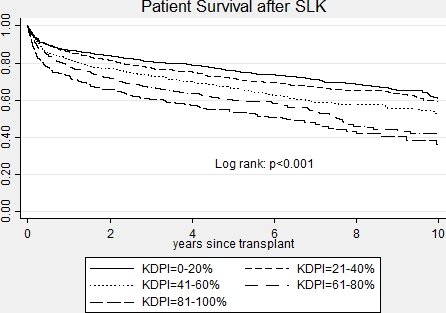Diminished Survival After Simultaneous Liver-Kidney Transplant With Increasing Kidney Donor Profile Index Score
Transplant Center, University of Texas Health Science Center, San Antonio, TX.
Meeting: 2015 American Transplant Congress
Abstract number: 513
Keywords: Donors, Kidney/liver transplantation, Liver transplantation, marginal, Survival
Session Information
Session Time: 8:30am-10:00am
 Presentation Time: 9:15am-9:30am
Presentation Time: 9:15am-9:30am
Location: Terrace Ballroom 1, 2, 3
BACKGROUND: Since the introduction of MELD, the number of simultaneous liver-kidney (SLK) transplants has greatly increased. Renal failure after liver transplant is associated with a four-fold increase in mortality. However there is scant data regarding the suitability of marginal renal allografts for SLK transplant. With the kidney donor profile index (KDPI) score, there is increased potential to measure the quality of renal allografts. Our aim was to examine the relationship between KDPI and patient survival after SLK transplant.
METHODS: National UNOS data from 2002-2013 for adult deceased donor SLK transplants (n=5,203) was analyzed. We examined differences in patient and graft survival according to KDPI and after adjusting for recipient characteristics. We also compared early renal outcomes including delayed graft function (DGF) and death-censored kidney failure within 1 yr and the corresponding mortality risks.
RESULTS: Patient survival is decreased for each increasing KDPI quintile with 1 yr survival of 86%, 85%, 82%, 78%, and 72% for KDPI 0-20%, 21-40%, 41-60%, 61-80%, and 81-100% respectively (p<0.001). After controlling for recipient age, MELD, HCV, and hospitalization status at time of transplant, there remained a significant increased hazard of death for each increased KDPI quintile (HR=1.22, 95%CI=1.16-1.27). This corresponds to more than twice the mortality hazard (HR=2.2, 95%CI-1.78-2.74) for the KDPI 81-100% grafts compared with KDPI 0-20%. In SLK recipients with DGF, there was a 60% increased hazard of mortality (HR=1.6, 95%CI=1.4-1.8), and kidney failure within the first year was associated with a more than 6-fold increased mortality hazard (HR=6.5, 95%CI=5.7-7.5).
DICUSSION: High KDPI kidneys are associated with poor renal outcomes after SLK transplantation. The impact of renal graft failure on patient survival after SLK transplant is profound. Further consideration should be given to minimizing the risks of pursuing SLK transplantation with high KDPI grafts, but this must be balanced against the waitlist mortality risks in this very “sick” group of transplant candidates.

To cite this abstract in AMA style:
Jay C, Halff G, Abrahamian G, Washburn K. Diminished Survival After Simultaneous Liver-Kidney Transplant With Increasing Kidney Donor Profile Index Score [abstract]. Am J Transplant. 2015; 15 (suppl 3). https://atcmeetingabstracts.com/abstract/diminished-survival-after-simultaneous-liver-kidney-transplant-with-increasing-kidney-donor-profile-index-score/. Accessed December 19, 2025.« Back to 2015 American Transplant Congress
